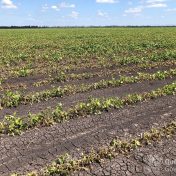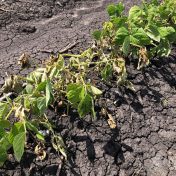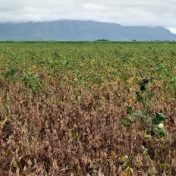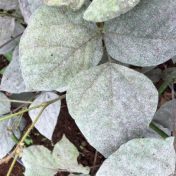Disease surveys across southern Queensland have revealed a high incidence of Downy mildew in several soybean crops in April 2022. The downy mildew pathogen, Peronospora manshurica, infects crops during periods of rainy, humid weather. Though widespread, the disease is likely to have a minimal impact on yields. The pathogen can survive between soybean crops in infected seeds, on volunteer soybeans or alternative… Read more »
After the wet weather in recent weeks there have been several reports of powdery mildew in mungbeans across Queensland and northern New South Wales, and Fusarium wilt has been found in several southern Queensland crops. Monitor crops closely for disease symptoms, and contact our plant pathologist, Lisa Kelly at [email protected] or 0477 747 040 for further information on disease diagnosis…. Read more »
Root rot reported in Burnett peanuts The DAF pathology team has recently received peanut samples with Neocosmospora root rot from crops growing in the Burnett region. Neocosmospora root rot is a sporadic but potentially severe disease caused by the fungus Neocosmospora vasinfecta var. africana. Outbreaks have occurred previously in the Burnett region in 2005, and also in the Emerald region… Read more »
The DAF pathology team has recently received reports of ergot in sorghum panicles growing near Toowoomba in southern Queensland. Sorghum ergot is caused by the fungus Claviceps africana. The disease can result in poor seed set, lower grain quality, and can cause harvesting issues due to the sticky honeydew on sorghum panicles. Infected grain will be replaced by fungal sclerotes… Read more »
Halo blight, caused by a bacterial pathogen (Pseudomonas savastanoi pv. phaseolicola) is one of the major diseases of beans world-wide, particularly in temperate regions. In mungbean, symptoms on leaves start as small, water-soaked lesions that are surrounded by a yellow-green halo (Figs 1 and 2). Symptoms may be visible at the 1st or 2nd trifoliate leaf stage and are often… Read more »
From this winter, the Beatsheet will start expanding to incorporate information on broadacre crop diseases (including alerts, identification and management). Recent alerts have been issued to watch for the diseases below: Ascochyta blight – reported in chickpeas in the eastern Downs Cereal rust – reported from southern Queensland and northern New South Wales. Bean yellow mosaic virus – detected in… Read more »
Several growers and agronomists across southern Queensland have reported extensive damage to their mungbean crops due to Fusarium wilt this season. Large areas of affected paddocks have plants that are wilted or dead, resulting in significant yield losses. The results of DAF annual disease surveys over the last five years have found that the disease is most common in crops… Read more »
Since early March 2020, soybean growers in the Burdekin have seen significant damage to their crops. Close inspection of crops found many with soybean stem fly damage as well as leaf spots, and stem and pod lesions. Severely affected plants have suffered complete and rapid leaf defoliation. In many crops, plants did not collapse until the late pod-fill stage, when… Read more »
Recent rainfall has led to opportunistic late plantings in some areas. The current high relative humidity may also lead to an increased risk of disease in some crops. Department of Agriculture and Fisheries (DAF) plant pathologists are encouraging Northern Region grain growers to submit disease samples (particularly powdery mildew in mungbeans) for diagnosis as part of effective paddock monitoring and… Read more »









